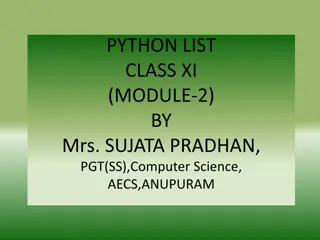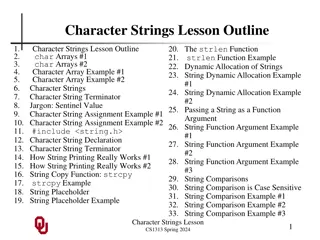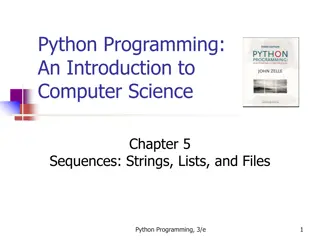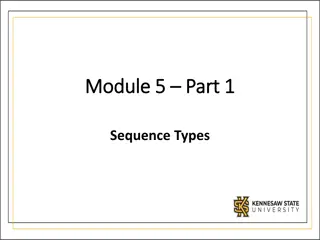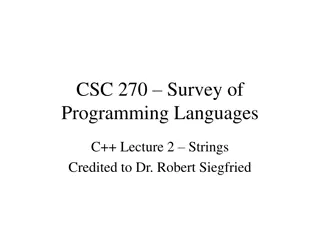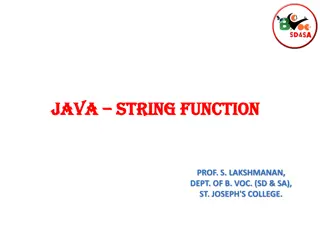
Differences Between Python Strings and Lists
Explore the distinctions between Python strings and lists in terms of mutability, homogeneity, slicing, concatenation, and more. Gain insights into the similarities and differences that exist between these fundamental data structures in Python programming.
Download Presentation

Please find below an Image/Link to download the presentation.
The content on the website is provided AS IS for your information and personal use only. It may not be sold, licensed, or shared on other websites without obtaining consent from the author. If you encounter any issues during the download, it is possible that the publisher has removed the file from their server.
You are allowed to download the files provided on this website for personal or commercial use, subject to the condition that they are used lawfully. All files are the property of their respective owners.
The content on the website is provided AS IS for your information and personal use only. It may not be sold, licensed, or shared on other websites without obtaining consent from the author.
E N D
Presentation Transcript
Lists vs Strings CMSC 201
Overview Python strings and lists are similar but different. Similar: syntax, access mechanisms, operators Different: Strings are immutable, lists are mutable Strings are homogeneous, lists are heterogeneous myString[1] is a string, myList[1] might not be a list
Similar myList = [0, 1, 2, 3, 4, 5, 6, 7, 8, 9] myString = "abcdefghijklmnopqrstuvwxyz" Use the len( ) function to get the size. len(myList) == 10 len(myString) == 26
Similar Empty list and empty string: myList = [] myString = ""
Similar myList = [0, 1, 2, 3, 4, 5, 6, 7, 8, 9] myString = "abcdefghijklmnopqrstuvwxyz" Use the [] to get components. myList[3] gives 3 myString[3] gives "d" myList[-1] gives 9 myString[-2] gives "y"
Similar myList = [0, 1, 2, 3, 4, 5, 6, 7, 8, 9] myString = "abcdefghijklmnopqrstuvwxyz" Use the [:] to get sub-lists and substrings. myList[3:7] gives [3, 4, 5, 6] myString[3:7] gives "defg" This is the slicing operator.
Similar myList = [0, 1, 2, 3, 4, 5, 6, 7, 8, 9] myString = "abcdefghijklmnopqrstuvwxyz" More slicing tricks. myList[:7] gives [0,1, 2, 3, 4, 5, 6] myString[:7] gives "abcdefg" myList[-3:] gives [7, 8, 9] myString[-3:] gives "xyz"
Similar L1 = [0, 1, 2, 3 ] L2 = [ 4, 5] str1 = "abcdefghij" str2 = "klmno" Use + operator for concatenation. L1 + L2 gives [0,1, 2, 3, 4, 5] str1 + str2 gives "abcdefghijklmno"
Different: Lists are mutable myList = [0, 1, 2, 3, 4, 5, 6, 7, 8, 9] myList[4] = 44 changes myList to become: [0, 1, 2, 3, 44, 5, 6, 7, 8, 9]
Different: Lists are mutable myList = [0, 1, 2, 3, 4, 5, 6, 7, 8, 9] myList[4:7] = [11, 22] changes myList to become: myList = [0, 1, 2, 3, 11, 22, 7, 8, 9]
Diff: Strings are immutable myString = "abcdefghijklmnopqrstuvwxyz" myString[4] = "X" is an error
Strings are homogeneous myString = "abcdefghijklmnopqrstuvwxyz" each myString[i] has the same type, a string.
Lists can be heterogeneous myList= [ "car", 5, True, 76.2 ] is perfectly legal. myList[0] is a string myList[1] is an int myList[2] is a boolean myList[3] is a float
Lists can be heterogeneous myList= ["car", 5, [True, "blue"], 76.2] is perfectly legal. myList[0] is a string myList[1] is an int myList[2] is a list myList[3] is a float
Different myList = [0, 1, 2, 3, 4, 5, 6, 7, 8, 9] myString = "abcdefghijklmnopqrstuvwxyz" Then, myList[7] is an integer myString[7] is a string "h" myString and myString[7] are both strings.

